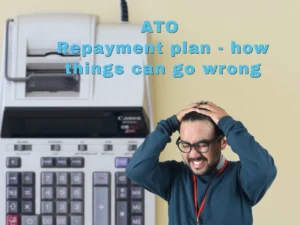Defaulting on ATO payment plans
If you have an ATO debt you can’t pay upfront, you can arrange an ATO payment plan. This is an agreement between you and the ATO where you agree to pay off your tax debt over time in instalments. In return, the ATO agrees not to use its debt collection powers against you.
Getting into a payment arrangement with the ATO is one thing. Keeping the payment arrangement on track is a different story. We have listed just some of the ways your payment plan can default.
Payment not being received on time
This might seem very obvious, but payment arrangements often default because of late payment. Usually, the payment is made on the due date and time isn’t allowed for the payment to clear into the ATO’s system.
It’s important to remember that the due date for payment is when the payment should be received by the ATO. This keeps your ATO payment plan in check
Make sure to check how long your payment type takes to clear to know your payment will be processed on time.
Paying into the wrong account
If you’re running a business, you will usually have more than one account with the ATO.
You will usually have an income tax account and an integrated client account (which is for your GST, pay-as-you-go withholding, etc.). You might also have other accounts, such as:
- A legal action account – you will have this if the ATO has initiated debt recovery proceedings against you for unpaid tax.
- A superannuation guarantee account – you will have this if you have missed payments for your employees’ superannuation.
- It can be challenging to keep track of all these accounts. But it is essential that you do – especially when you’re in a ato payment plan or arrangement.
- Let’s say you have two tax debts (for different types of tax). These debts might be owed on your integrated client and income tax accounts. When you enter into a payment arrangement with the ATO for these accounts, the ATO views these as two separate arrangements that require separate monthly payments.
- So, you may have a payment arrangement of $1,000 per month in your integrated client account and $400 per month in your income tax account. The payment details for each of these accounts will be different. This means you must be careful when making your monthly payments. Make sure that each payment goes into the correct account. If you accidentally make both payments to the same account, one of your ATO payment plan arrangements will default.
- Unfortunately, the ATO doesn’t monitor your accounts to ensure your payments are going into the right place – this is up to you! So be careful – you don’t want a simple mistake to trigger a default.
- Your ignore the payment all together
Your ato payment is less than expected!
The ATO’s system looks at each payment it receives and matches it up against what it expects. If one payment is less than expected, it will flag a default. For example, a default happens if the ATO expects $1,000 per month, and you pay $1,200 monthly and $800 the next month. Your agreement with the ATO is to pay $1,000 monthly; anything less means a default.
Your extra $200 payment from the month before is voluntary. It doesn’t apply as a pre-payment toward next month’s payment.
Similarly, getting a tax credit or refund (for example, a GST credit) does not affect your payment plan. However, it won’t replace your regular required instalment payment, so you must keep paying your usual monthly amount.
- Not keeping up with all future obligations
If you’re in a payment arrangement, you must ensure you meet all your future tax obligations. This means that you must submit all your future lodgements on time and pay any new tax debts by the due date. These new debts aren’t part of the payment arrangement – if you don’t pay them, you will default.
What to do if you think you’re going to default
If you can’t pay your instalment by the due date, the best thing to do is contact the ATO. You should do this as soon as you realise you have a problem. You may be able to renegotiate the arrangement so that it doesn’t default. It’s much better to do this than wait until a default has happened.
Your payment and default history influence the ATO’s decision about whether you can enter into a new arrangement and what the terms of that arrangement should be. For example, if you have a terrible compliance history, the ATO may ask you to pay a large upfront payment or pay by direct debit.
A poor compliance history can also mean that the ATO will only agree to a temporary payment arrangement – e.g. 6 months instead of a year.
Because your payment history influences the terms of future payment arrangements, it’s best to keep in contact with the ATO. Try to renegotiate your payment arrangement before a default happens.
What happens if you default
If you are on an Australian Taxation Office ATO payment plan and you default on your payments, there are several steps that may be taken by the ATO:
Payment Default Notice: The ATO will typically send you a payment default notice if you miss a payment on your payment plan. This notice will inform you that you are in default and will usually provide instructions on what you need to do to rectify the situation.
Contact from ATO: The ATO may contact you via phone, email, or mail to discuss the default and try to work out a solution. They may be willing to modify your payment plan or negotiate a new arrangement based on your financial circumstances.
Additional Penalties and Interest: When you default on your payment plan, the ATO may impose additional penalties and interest charges on the outstanding amount. These can increase the total amount you owe.
Debt Collection: If you continue to default on your payments and do not respond to the ATO’s attempts to contact you or make arrangements, the ATO may escalate the matter to a debt collection agency.
Legal Action: In extreme cases, if you consistently fail to make payments and do not respond to the ATO’s attempts to resolve the issue, the ATO may take legal action to recover the debt. This could include obtaining a court judgment against you.
To avoid defaulting on your ATO payment plan, it’s essential to communicate with the ATO as soon as you encounter financial difficulties.
If your payment arrangement defaults, the ATO can use one of its many debt collection powers against you. This can include issuing a garnishee notice to your bank or serving you with papers to try to wind up your company or make you bankrupt.
You should make every effort to ensure you don’t default as it is getting more difficult to renegotiate with the ATO. The ATO is getting tougher to deal with and can ask for lots more information about your finances and assets to ensure you won’t default again.
Contact us for assistance and allow us to negotiate on your behalf . Contact Michelle at our Office on 95979966



